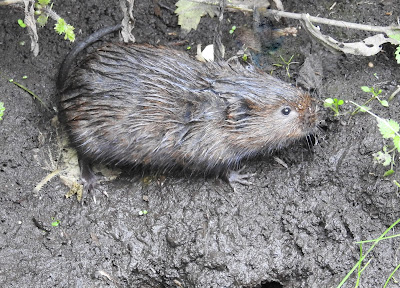Monday, 28 August 2017
Otter Bottom
A surprise last night: this flash of full-grown adult otter disappearing upstream. I've seen otters before here, in Sept 2014 (previous otters) and twice over the years found their spraint, but I don't believe they use this tiny stream as anything other than a corridor. It's barely deep enough for an otter to paddle in, and only about two-otters-wide. Otters will take water voles but are too big to fit down the burrows in pursuit, so I'm hoping my little team will stay safe.
I've no idea whether this is related to the change in my voles' routines!
Saturday, 26 August 2017
Nesting
I'm getting nightly sightings but still nothing in the day. It was lovely to capture footage of this nesting vole, though. I've seen voles gathering bedding before, but never managed to catch it on camera. Not sure whether this is a female getting ready for a litter, or whether voles of both sexes gather material this way. Does anyone know?
Edited: yes, Derek Gow, patron saint of water voles does. He says: "Both sexes are perfectly capable of building nests. Males underground tend to avoid females as they are pretty belligerent. We don't know if the males play a direct role in rearing young but they are tolerant of them." So this vole in the video clip could be male or female.
Tuesday, 22 August 2017
Nocturnal Voles
18th August
19th August
20th August
21st August
22nd August
I haven't seen any voles out in daylight for ten days now, but there've been fresh droppings every time I've looked so I knew they were still around. Putting down a trail cam revealed plenty of activity, but all taking place at night. This is behaviour I normally see towards the middle of September, so I'm surprised. Unless there's a new predator about, and that's affecting their routine?
Sunday, 13 August 2017
One of Those Days
Possibly a September Thorn moth.
Below: a variety of common lizards basking at Llanymynech Rocks this morning.
So much of wildlife-watching is waiting, and often failing to see what you went to look for. But today began with two new-to-me species of moth, a Bulrush Wainscot and a Common Wainscot, plus this characterful Thorn. Mid-morning a trip to Llanymynech Rocks revealed a dozen or so lizards happy to pose while I photographed them. I was very taken with the variety of colours they come in. The air was full of butterflies, especially Common Blues and Small Coppers. Then this evening, a water vole, very close and bold (until I moved!).
Some days are magical.
Monday, 7 August 2017
How to Detect Invisible Voles
Below: plenty of water vole droppings.
A burrow that's clearly occupied.
As I've said, this time of year the voles go suddenly very shy; I don't know if it's to do with populations thinning out as young disperse, but it happens almost overnight and, for the dedicated vole-watcher, it's unnerving. When you were used to seeing several voles a day and then you're down to nothing, how do you know they haven't all packed up and gone, or been wiped out?
Because the signs are all still there. The daily fresh droppings, nibbled vegetation, the visibly-in-use burrows, the mysterious clouds of mud that bloom as a nervous vole shoots past under water. And there are plopping noises, and violent ripples, and sometimes the sound of roots being crunched under your feet. So it's a matter of keeping the faith, till their collective psyche becomes more confident again and you start getting sightings once more.
Labels:
burrow,
field off Edgeley Road,
latrine,
Prints,
Sighting
Subscribe to:
Comments (Atom)
























